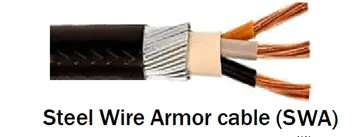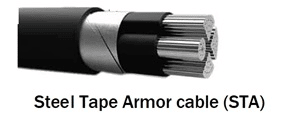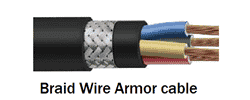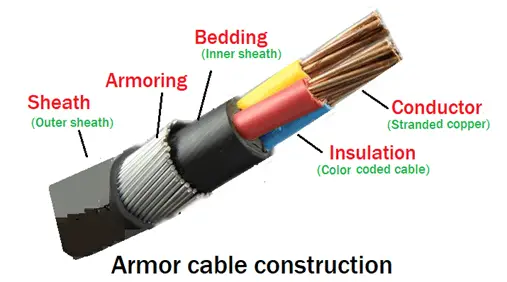An armoured cable has a metallic layer of strips, or threads that protect the conductors from external forces. The external vulnerable force to cables are rodents, and accidental impacts. It also prevents any internal irregularities from causing the release of dangerous energy levels to the outside in environments.
Armoured cables are insulated with non-flame propagating thermoplastic compounds with low emission of smoke and toxic gases, covered with metal armour.
Installation of armoured cable is fast and economical. There is no need of rigid conduit pipe, such as threading, bending, making support when we use armored cable.
It also avoids waste because the armoured cable are available in continuous rolls of convenient length. The armour provides the ultimate protection against electrostatic, magnetic, and common modes.
What is the armoured cable?
The armoured cable has an extra protective layer to keep it away from unwanted cut or damage. The armour made of aluminium wires placed under the sheath to protect the conductor, and insulate the layers.
Why are armoured cables used?
For outdoor installation or direct burial applications, there is a need of mechanical protection of electrical cables. The aluminium wire armour (AWA) and steel wire armour (SWA) provide the mechanical protection. The armoured wire has higher tensile loads.
The structure of the armour guarantees maximum resistance to crushing, cutting, and wear.
Classifications of Armoured Cables
We can classify the armoured cables into steel wire, steel tape, aluminum wire and aluminum alloy.
- Steel wire armoured cables ( SWA)
- Steel tape armoured cables ( STA)
- Aluminium wire armoured Cables ( AWA)
- Braid wire armour cable
Now, we will discuss the types of armoured cables in detail.
Steel Wire Armour Cable (SWA)
Steel wire armoured cable has a strong steel wire conductor assembled with a layer of insulation. The steel wire armour is abbreviated as SWA.

The Steel armoured cable (SWA) is the most common type of armoured cable in electrical power distribution. It is a heavy-duty electrical power cable suitable for mains supply. We use this type of cable in 11 kV and 33 kV underground & cable ducts electrical installations.
The main purpose of the shielded layer steel wire armoured cable is to improve the tensile strength and compressive strength. It also provides mechanical protection. Further, It also lengthens the service life and improves the anti-interference of the cable through shielding protection.
The steel wire armour withstands high pull loads, and therefore it is widely used in multicore cable.
Blue sheathed steel wire armoured (SWA) cables are most suitable for instrumentation applications
Steel Tape Armour Cable (STA)

Steel tape and wire armour layers have high permeability and excellent magnetic shielding effect and resist low-frequency interference. The use of steel tape armouring is a popular method of protecting fibre optic cables.
Aluminum Wire Armour Cable (AWA)

Aluminium wire armoured cables provide protection against mechanical stress, making armoured cables suitable for direct burial and outdoor or underground use.
When current flows through a cable, it generates a magnetic field. The magnetic field induces an electric current (eddy currents) in the steel armour, which can cause overheating in AC systems. Aluminium is a non-magnetic material, non-magnetic aluminium reinforcement prevents this.
Braid Wire Armour

Braided armour cable has several fine copper wires interwoven into a tightly meshed tubular structure. It wraps around a conductor. Braided armour cables suppress magnetic fields, reducing electromagnetic interference between and nearby cables.
Typically copper braided cables are used in environments that transmit high-speed signals which are also susceptible to mechanical damage.
Difference Between Steel Wire Armoured (SWA) Cable and Steel Tape Armoured Cable (STA)?
We use steel tape armoured cable (STA) for direct buried cable or pipe laying, common ground, tunnel, etc. STA cables are less expensive than SWA cables.
Steel wire armoured (SWA) cable can withstand the general longitudinal tension, hence it is suitable for short-distance aerial laying or vertical or vertical laying.
Because the production of SWA armoured cables is more difficult, the cost is higher. In general, it is according to the use of different ways of the environment and the choice of different shielded SWA cables.
SWA cables are suitable for network cable, armoured cable, power cable, or leaflet armoured cable.
Construction of Armoured Cable

Conductor
It is the material through which the current circulates. The conductor carry the electric current from one place to another. Actually, the conductor is an inner part of the cable.
Copper has more conductivity than aluminum. However, both copper & aluminum is the best choice for an electric conductor.
Insulation
Insulation of any of the following compounds: PVC, PVC+NYLON, Low-Density Polyethylene, XLP, depending on the use of the cable.
Cross-linked polyethene (XLPE) finds its applications in various power cable system because it has water-resistant and excellent electrical properties. The conductive parts of the cable must not come in the contacts of other conductors or metallic parts. The cable insulation provides separation between the conductive and non conductive parts of the cable.
Bedding
The bedding protects the sheath from mechanical damage. Bedding creates a protective barrier between the inner and outer layers of the cables.
Armour
Steel wire armour provides mechanical protection to cable. It means the armoured cable can withstand higher stresses. It is also suitable for underground installations. The shield is normally grounded, and can sometimes be used as a protective circuit conductor (”ground wire”) for cable-supplied equipment.
Sheath
The sheath provides good flexibility and holds all the cable components together. Sheath protects the cable from UV, water ingress, and differing soil compositions.
It provides additional protection against external stresses. Other sheath materials are polyethene (PE), Low Smoke Halogen Free (LSHF), PTFE, Rubber, and Silicone are very few to mention.
Read Next: